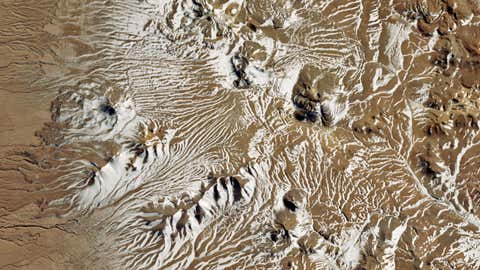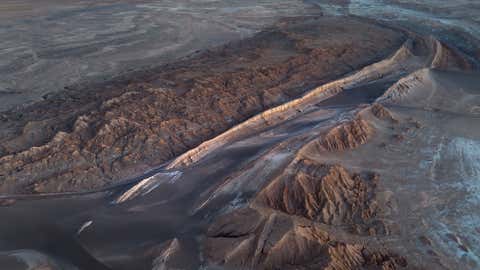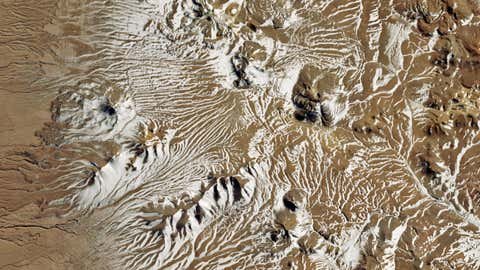

This recently-released image from NASA gives a mesmerizing, bird’s eye view of an unusual event in what’s widely considered the driest non-polar place on Earth – the Atacama Desert.
The satellite photo shows a rare snowfall in the desert plateau that lies high in the Andes Mountain range in northern Chile.
The snow coated the region on June 25, 2025, and meteorologists there say it’s the first time the area has seen snow in 10 years.
So why is snow and rain so rare here? Well, the Andes Mountains produce a rain shadow over the desert, blocking precipitation. Then, cold air from the Humboldt or Peru/Chile Current from the west limits cloud development, says NASA.
(MORE: See A Lego Man’s Epic Space Journey)


File – In this aerial view, twilight falls on the Valle de la Luna in the Atacama Desert, considered the driest place on earth. Much of the desert receives less than half an inch of rainfall per year and some areas none at all for hundreds of years.
(John Moore/Getty Images)
This snow event was produced by what meteorologists call a “cutoff” low. Weather.com’s Chris Dolce explains, “This refers to a low-pressure system in the atmosphere high above us that becomes separated from the main jet stream after it develops, which causes it to get stuck for a time, or ‘cutoff.'”
In this case, Dolce says the low was stalled well off the west coast of South America over the Pacific Ocean for several days. It finally began to move eastward toward Chile on June 24-25 while weakening, but still contained enough moisture to squeeze out snowfall.
(MORE: Images Show The Universe Like Never Before)
That surprising snowfall temporarily suspended operations at the Atacama Large Millimeter/submillimeter Array or ALMA, which NASA calls one of the most powerful radio telescopes on our planet.


The antenna array at the Array Operations Site of ALMA Observatory.
(Getty Images)
ALMA is located on the Chajnantor Plateau in northern Chile, sitting at more than 16,000 feet above sea level. The snow fell on the Operations Support Center, the base camp, and other facilities.
The exceptionally dry and clear skies over the Atacama Desert have made it a hub for astronomy research. It is home to several major observatories and an array of powerful telescopes.
However, the snow didn’t stay around for very long, even at that high elevation. NASA attributes that to the unusually intense sunlight in the region. Scientists say the area sees “some of the highest levels of solar irradiance on Earth.”






